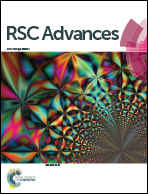A versatile in situ etching-growth strategy for synthesis of yolk–shell structured periodic mesoporous organosilica nanocomposites†
Abstract
This paper describes a versatile in situ etching-growth strategy for the preparation of periodic mesoporous organosilica (PMO) composites with yolk–shell structure, which can generate the void space and construct the outer PMO shells at the same time. The superparamagnetic yolk–shell Fe3O4@PMO composites (YS-Fe3O4@PMO) with radical mesochannels were also synthesized with this unique in situ etching-growth strategy by using Fe3O4@nSiO2 nanoparticles as the initial core. This method provides a general route for the synthesis of yolk–shell structured nanomaterials with different sized void spaces, various chemical composition cores, as well as organic functional PMO shells with radical mesochannels. Moreover, we can also obtain asymmetric or asymmetric hollow Fe3O4@PMO materials with a cubic PMO shell. All the magnetic mesoporous composites possess very high surface areas and large pore volumes (586 m2 g−1 and 0.52 cm3 g−1 for YS-Fe3O4@PMO, 946 m2 g−1 and 0.86 cm3 g−1 for asymmetric hollow Fe3O4@PMO). Gold nanoparticles could be encapsulated and confined in the void space of YS-Fe3O4@PMO composites through an in situ salt impregnation. The resultant YS-Fe3O4@Au@PMO nanomaterials could be used to catalyze the reduction of 4-nitrophenol with an ultrahigh efficiency (k = 0.01197 s−1). The magnetic catalysts could be easily recovered by a magnet and reused for more than 10 cycles with efficiency retained as high as 95%.


 Please wait while we load your content...
Please wait while we load your content...